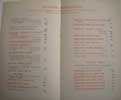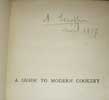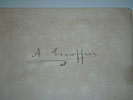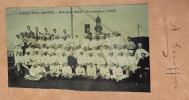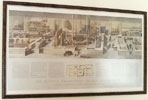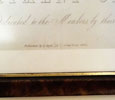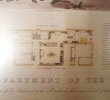A framed advert - circa 1890.
Victoria Embankment. LONDON. PERFECTION OF LUXURY AND COMFORT. Artistic Furniture. Shaded Electric Lights everywhere at all hours of night and day. NO GAS. The Finest River and Garden View in London, giving a Panorama of the Thames from Battersea to London Bridge. All the Corridors thoroughly Warmed in the Cold Weather by Hot Water. Suites of rooms on every Floor, with Private Bath Rooms, &c. Sixty-seven Bath Rooms. No charge for Baths. Large and Luxurious “Ascending Rooms” running all night. Top Floor Rooms equal in every respect to the Lowest. Large Central Courtyard with Plants, Flowers, &c. (A black and white finely detailed etching of the Savoy as seen from the Thames.) THE RESTAURANT Open to the Public. Luncheons and Dinners served on the Terrace overlooking the beautiful Embankment Gardens and River. This Terrace is enclosed by glass, and warmed during the winter. In the hot weather, dinners, &c, , are served in the open air. THE ONLY OPEN AIR RESTAURANT IN LONDON. The Restaurant has been organized under the superintendanceof M. RITZ, the well-known Hotel Manager from Monte Carlo, Cannes, and Baden-Baden, and of the popular Maitre d’Hotel “Francois” (M. RINJOUX), of the Grand Hotel at Monte Carlo. Manager of the Restaurant – M. ECHENARD. Chef, -- M. CHARPENTIER. The cuisine rivals the most famous Cpntinental Cafes. For tariff and rooms apply to the Manager of the Hotel, Mr. HERDWICKE.
247 x 177mm. A one page light brown advertisement for the Savoy Hotel, London. Circa 1890. A small part of the top right hand corner missing. A small chip missing on the side. Not affecting the text. Nicely mounted and framed in a fine gold frame with a 2” cream coloured cloth mount. The whole measuring 415 x 325mm. Overall very nice condition. A very rare item of ephemera.
- The facts behind this Savoy Hotel advertisement are very interesting and can be dated quite accurately. The names and the places are all extensively recorded in the numerous biographies of Escoffier and Ritz. It starts with a very persuasive and intelligent entrepreneur named Richard D’Oyly Carte who had built and opened the Savoy Theatre between the Strand and Thames embankment, London. It was the most modern theatre in London with the newly invented electric lighting. The theatre was very popular and D’Oyly Carte wisely realised that the theatre-goers needed a nearby place to dine after the performances. The land behind the theatre was known as the old ‘Savoie Mannor’. A sloping field overgrown with weeds and littered with bottles that looked out upon the coal wharves, barges and general flotsam of the Thames Embankment. D’Oyly Carte purchased the land, drew up plans for a hotel and started construction on 1884. The Savoy Hotel was opened on the 6th August, 1889. It was extremely popular in the beginning but D’Oyly Catre noticed that the clientele numbers had started to drop after three months. It was obvious that the food was not up to scratch nor the management capable of dramatically improving the needed standards. Lilly Langtry was a good friend of D’Oyly Carte. She urged him to approach Cesar Ritz the famous hotelier, to take advantage of Ritz’s fame after he had established and managed some of the most luxurious hotels in the world such as the Ritz Hotels in London and Paris, also the Grand Hotel in Rome, the L’Hotel Salasamaggiore in the province of Parma etc etc. Ritz also had a longstanding partnership with Auguste Escoffier who managed the kitchens of those famous hotels. Both of them were dedicated to the highest standards, and they were as famous as the establishments they served. Ritz was initially opposed to going to England as he and Escoffier were already very committed and busy. D’Oyly Carte paid him handsomely just to visit and in 1889 Cesar stayed in and inspected the Savoy. On returning home he told his wife the food was terrible and weather was worse. Equally, he was very excited about the wealth of the clientele and the beauty of hotel. In January 1890 Cesar signed a contract to manage the Savoy Hotel. His first task was to convince Escoffier to come and manage the Kitchens and Restaurants. The manager of the restaurant, M. Echenard, (at the bottom of the advert) was a Master of Wine and became Cesar’s assistant. Another name at the bottom is the Manager of the Hotel – Mr. Hardwicke. He proved unable to keep the initial business nor manage the Hotel as it needed to be. Another name is the Chef. M. Charpentier. Before coming to the Savoy he had worked for Rothschild but did not have the notion to run a large restaurant with a’ la carte menus. The Prince of Wales complained that the cooking was as dull as Windsor Castle’s. Escoffier finally accepted the position of Maitre Chef de Cuisine and started in the Kitchen on April 1890. It was not without drama. There was very bad feeling about the dismissals and when Escoffier walked into the kitchen on his first day he found everything destroyed. To save the day he asked his friend Louis Peyre who managed the Kitchens of the Charing Cross Hotel to help. Peyre supplied everything that day and gave Escoffier time to organise the kitchen for the next day. As the advertisement also has Ritz’s name on it as the manager of the Restaurant, it must have been printed between January 1890 (probably on Cesar’s initiative) and April 1890, sometime just before Escoffier started.


click on image to enlarge

Ephemera category
ref number:
11189 



